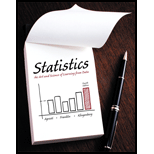
Smoking cessation A study published in 2010 in The New England Journal of Medicine investigated the effect of financial incentives on smoking cessation. As part of the study, 878 employees of a company, all of whom were smokers, were randomly assigned to one of two treatment groups. One group (442 employees) was to receive information about smoking cessation programs; the other (436 employees) was to receive that same information as well as a financial incentive to quit smoking. The outcome of interest of the study was smoking cessation status six months after the initial cessation was reported. After implementation of the program, 14.7% of individuals in the financial incentive group reported cessation six months after the initial report, compared to 5.0% of the information-only group. Assume that the observed difference in cessation rates between the groups 114.7% – 5.0% = 9.7%2 is statistically significant.
- a. What does it mean to be statistically significant? (choose the best option from (i)–(iv))
- i. The financial option was offered to 9.7% more smokers in the study than the nonsmokers who were employees of the company.
- ii. 9.7% was calculated using statistical techniques.
- iii. If there were no true impact of the financial incentive, the observed difference of 9.7% is unlikely to have occurred by chance alone.
- iv. We know that if the financial incentive were given to all smokers, 9.7% would quit smoking.
- b. Is the difference between the groups attributable to the financial incentive?
- c. Is the difference between the groups attributable to the financial incentive?
Want to see the full answer?
Check out a sample textbook solution
Chapter 1 Solutions
Statistics: The Art and Science of Learning from Data (4th Edition)
 MATLAB: An Introduction with ApplicationsStatisticsISBN:9781119256830Author:Amos GilatPublisher:John Wiley & Sons Inc
MATLAB: An Introduction with ApplicationsStatisticsISBN:9781119256830Author:Amos GilatPublisher:John Wiley & Sons Inc Probability and Statistics for Engineering and th...StatisticsISBN:9781305251809Author:Jay L. DevorePublisher:Cengage Learning
Probability and Statistics for Engineering and th...StatisticsISBN:9781305251809Author:Jay L. DevorePublisher:Cengage Learning Statistics for The Behavioral Sciences (MindTap C...StatisticsISBN:9781305504912Author:Frederick J Gravetter, Larry B. WallnauPublisher:Cengage Learning
Statistics for The Behavioral Sciences (MindTap C...StatisticsISBN:9781305504912Author:Frederick J Gravetter, Larry B. WallnauPublisher:Cengage Learning Elementary Statistics: Picturing the World (7th E...StatisticsISBN:9780134683416Author:Ron Larson, Betsy FarberPublisher:PEARSON
Elementary Statistics: Picturing the World (7th E...StatisticsISBN:9780134683416Author:Ron Larson, Betsy FarberPublisher:PEARSON The Basic Practice of StatisticsStatisticsISBN:9781319042578Author:David S. Moore, William I. Notz, Michael A. FlignerPublisher:W. H. Freeman
The Basic Practice of StatisticsStatisticsISBN:9781319042578Author:David S. Moore, William I. Notz, Michael A. FlignerPublisher:W. H. Freeman Introduction to the Practice of StatisticsStatisticsISBN:9781319013387Author:David S. Moore, George P. McCabe, Bruce A. CraigPublisher:W. H. Freeman
Introduction to the Practice of StatisticsStatisticsISBN:9781319013387Author:David S. Moore, George P. McCabe, Bruce A. CraigPublisher:W. H. Freeman





